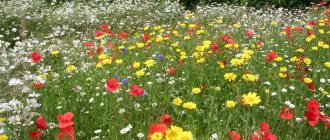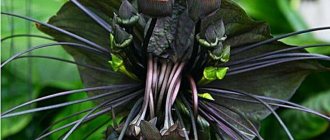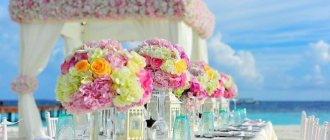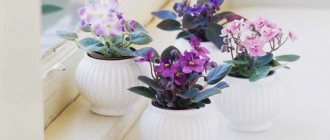Dieffenbachia.
Dieffenbachia is another plant familiar to us, which, unfortunately, contains alkaloids that, if any part of the plant is damaged, can cause burns and cause swelling and allergic reactions . As a rule, irritation does not appear on the skin immediately, but after some time.
This is interesting! In slave-owning Brazil, Dieffenbachia was used to punish guilty slaves. They were forced to eat a Dieffenbachia leaf, after which the slaves experienced swelling of the tongue and larynx. In this state they could not talk, which is why this method of punishment in Brazil was called silent rods.
Geranium
Yes, we didn't mix anything up. This plant is, of course, very useful. On the one hand, geranium is an excellent antiseptic, helps relieve stress and tension, and relieves pain from otitis media and sore throats. However, there are people for whom the smell of geranium can trigger a severe asthma attack and cause an allergic reaction. Geranium (as one of the poisonous indoor flowers) is also contraindicated for pregnant women, people with low blood sugar, young children and those taking birth control.
Hippeastrum.
Hippeastrum belongs to the Amaryllidaceae family. All plants of this family are very poisonous. As with the previous plant, all parts of the plant are dangerous, but the bulbs are especially dangerous. Hippeastrum juice contains the alkaloid lycorine, which has the ability to stimulate the vomiting center in the brain and cause poisoning of varying severity . If an animal decides to eat hippeastrum, this can lead not only to poisoning, but also to death. Fortunately, according to statistics, people usually experience problems with this plant only when they eat the bulb due to its similarity to onions.
Oleander.
An incredibly beautiful plant that is used in landscape design and is also cultivated as a beautifully flowering indoor plant. In addition, this plant is famous for its ability to absorb negative energy and toxins, while having a beneficial effect on people and animals. However, not everything is so smooth, and when interacting with it, precautions must be taken, because Oleander juice contains a number of cardiac glycosides that can cause strong effects.
Plants with bad energy according to folk signs
Everything in life has a second essence, and it is not always good. The same applies to plants, which are capable of harboring dangerous energy that has a detrimental effect on human health. There are many folk signs associated with such indoor flowers. According to popular belief, the following types of flowers are considered the most undesirable guests in the house.
Ivy
Ivy is a dark plant that has a connection with the other world. It was not without reason that ancient crypts were decorated with the image of a climbing ivy vine. Such a drawing is a symbol of the destruction of human order and the triumph of dark forces. Popular beliefs say that ivy is an energy vampire in the guise of a pretty plant, so our ancestors avoided growing it in their homes.
Sansevieria
Sansevieria is a beautiful crop, but very finicky and delicate. The flower is difficult to care for, and even with full compliance with all growing rules, the crop may die. It is believed that the plant attracts difficulties and troubles into the home of its owners.
Externally, the shoots of Sansevieria resemble snakes, therefore, in folk superstitions, the culture is associated with cruelty, aggression, and anger.
cacti
Surprisingly, cute and, at first glance, innocent cacti are also popularly considered not the best option for the home. Their appearance and essence are contradictory and ambiguous. The thorns symbolize the constant struggle for life, and the beautiful blooms reveal its meaning. Such inconstancy, as was popularly believed, could be transmitted to the owner of the flower.
Orchid
Orchid loves strong-willed and strong people, but culture will only bring trouble to indecisive individuals. The plant is a real energy vampire, capable of absorbing vital energy from everything that surrounds it. Therefore, people who are weak in spirit will face great difficulties and troubles if they place this beautiful flower in their home.
Palm trees
Palm trees grown independently bring prosperity and well-being to the home. But purchased or donated plants, alas, only cause trouble. Particularly “evil” are:
- Washingtonia;
- chamedorea;
- yucca;
- date fruit.
Plants have quite aggressive energy, so they are not suitable for the home. If you like plants of this type, it is better to place them in your office or other place.
Fern
Ferns of all types are common in homes. However, home owners make a big mistake, since such crops can cause allergies and headaches. And if you believe the signs, then the fern is the main obstacle to marriage for young girls.
Also read: Myrtle - a tree of peace and love on your window
Rose
Indoor roses are plants with powerful energy, the supply of which must be constantly replenished. And the plants do this at the expense of their owners. The result is a feeling of exhaustion, powerlessness, and moral fatigue.
Scindapsus
The plant is considered a "husband's herb". The presence of scindapus in the house scares away potential husband candidates from women. In view of this sign, unmarried girls are not recommended to take this crop into their home. But after marriage, growing scindapus is not prohibited.
Calla lilies
Callas are considered a symbol of sadness. They bring sadness and can even cause prolonged depression. The flower is associated with mourning and death, so it is not recommended for people who are particularly sensitive and prone to melancholy to keep calla lilies in the house.
Ficus
The beautiful ficus plant has not been spared superstitions either. Its presence in the house causes infertility in a man or woman. However, there is an opposite version, which says that culture brings prosperity and prosperity to the home.
Whether to believe the signs associated with indoor plants or not is everyone’s business. Most of the legends described are now considered to be empty superstitions, but there are also people who firmly believe in their veracity.
Cyclamen
It is believed that cyclamen in the home helps ward off bad dreams and fears, and it should be placed in the bedroom at the head of the bed. We will not argue about the magical power of Cyclamen, but we need to warn about its poisonous properties. Sometimes it is recommended to instill cyclamen root juice for sinusitis, but this should not be done under any circumstances. Not only can you burn the mucous membrane, but you risk getting a fever, sore throat and difficulty breathing. The most poisonous parts are the seeds and roots of the plant, the fresh juice of which can cause irritation or inflammation of the skin.
Castor bean
Among the plants that cannot be kept at home, castor beans should occupy one of the first places. This plant is usually grown outdoors in gardens, but some gardeners prefer to have it at home. The houseplant is valued for the beauty of the shape of its leaves, which have a dark purple color. However, castor bean seeds are very poisonous. If you chew or swallow such a seed, a person develops gastroenteritis and dehydration occurs due to diarrhea and vomiting. The liver and kidneys are also affected. Castor bean poison is one of the most powerful known biological poisons. So, one castor bean seed can kill a cat, two can kill a dog or a child, three or four will lead to the death of an adult.
The toxicity of castor bean seeds is associated with the protein ricin, which is present in them. Once in the body, this protein reacts with the cell’s ribosomes and interferes with protein synthesis. This leads to the death of cells and, as a consequence, the entire organism.
It is interesting to note that the oil obtained from castor bean seeds is one of the best laxatives. When preparing this product, it is subjected to heat treatment, which leads to the destruction of the poisonous ricin.
Currently, castor bean seed oil is used in the industry in the production of paints, varnishes and lubricants for automobile brake systems.
Which ones can you start?
In principle, there are no strict restrictions for indoor plants. You can have any flower you like, the main thing is to choose a suitable place for it and follow safety precautions.
However, the most favorable inhabitants of a living space are plants that purify the air and do not pose any danger. These include:
- Begonia;
- bamboo;
- Crassula;
- violets;
- Sansevieria;
- lemon;
- Kalanchoe.
All these plants will help create coziness in any room, complement the design, refresh the interior and purify the air in the room.
Rate this post
Which ones are better not to keep in the apartment?
The flowers listed above are undesirable for an apartment. In addition, the following categories of flora representatives will become undesirable residents for small apartments:
- Woody plants - they take up a lot of space and can fall over. If it falls on a child, it can cause serious injury.
- Spiny plants - including cacti. It’s not so scary if a person simply injects himself, but sometimes a cactus can shoot a thorn into the eye - the consequences will be very serious.
- Flowers in fragile pots - they always have a chance of breaking. The fragments can injure both an adult and a child or animal.
Important! It is also undesirable to grow indoor trees in an apartment for the reason that sooner or later they will reach the height of the ceiling. Many are sensitive to pruning. Therefore, it is worth assessing the prospects for growing the selected species in advance.
In the bedroom
Certain plants should not be placed in the bedroom (for various reasons). Some of them consume too much oxygen when breathing, creating a stuffy atmosphere. Others release stimulants into the air that will disrupt sleep.
You should refrain from using the following types in the interior:
- Ficus;
- indoor lilies;
- Orchids;
- Oleander;
- Ferns;
- Monsters.
If you want to grow these plants, you should place them in other rooms with good ventilation. For example, in the living room or kitchen.
In the nursery
For the nursery, the same prohibitions apply as for the bedroom - children do not need either stuffiness at night or excessive excitement. However, in addition to this, you should not use poisonous varieties for a children's room. After all, then if you neglect the baby a little, he will end up in the hospital with poisoning or burns.
Therefore, in addition to the types listed above, the following types cannot be placed in the children's room:
- Poinsettia;
- Jatropha;
- Adenium;
- Solyanum;
- Aroid.
Important! When designing a children's room, you should also remember the danger that cacti pose - their spines can be fatal for children.
Before placing flowers in a child's room, you need to carefully study the information about them to find out whether they pose a danger. It is necessary to additionally take into account the layout of plants in the nursery. It is important to organize the space so that the child cannot drop the flower and break the pot, because ceramic shards cause serious damage.
Adenium.
Adenium is an incredibly beautiful indoor plant, which is striking in its unusualness: a thick trunk, which in skillful hands takes the form of a cute bonsai, and stunning flowers. However, today Adenium is considered perhaps the most poisonous indoor plant. In Adenium, all parts of the plant are poisonous, including the juice. In addition, Adenium is quite toxic and can be harmful to people with asthma.
This is interesting! African tribes use Adenium juice to poison arrowheads











